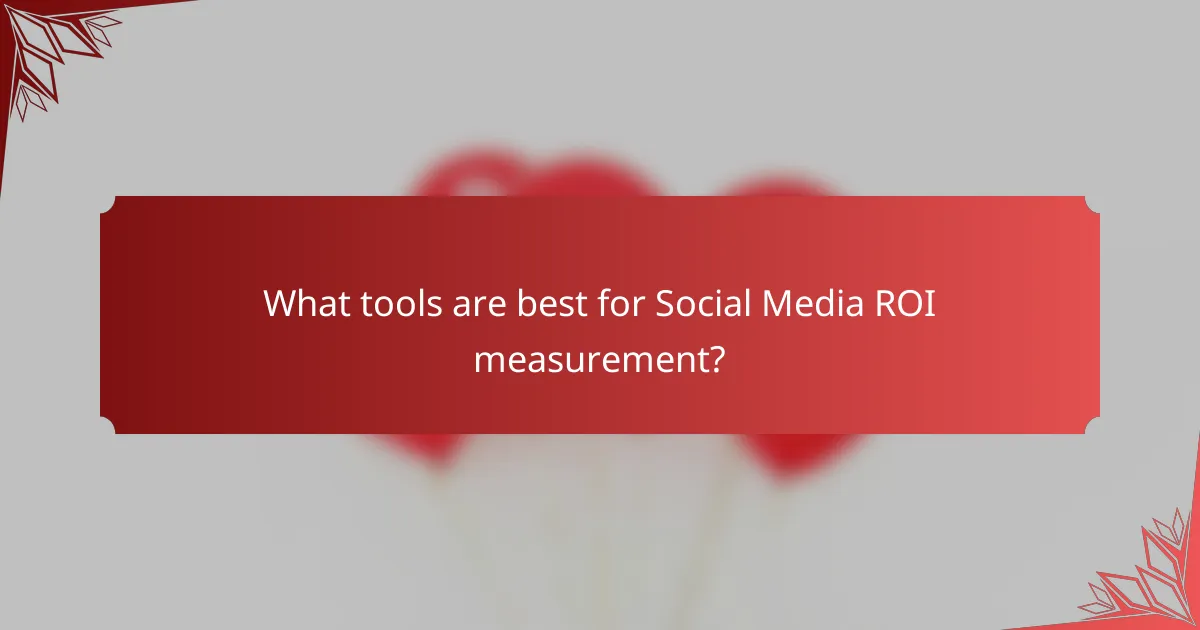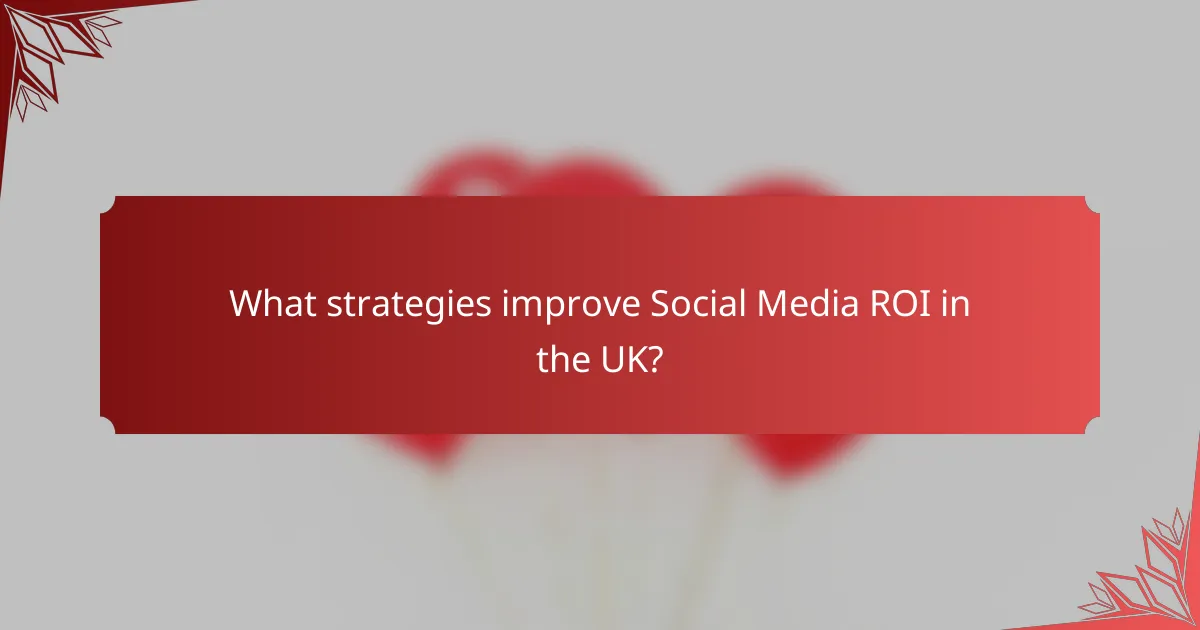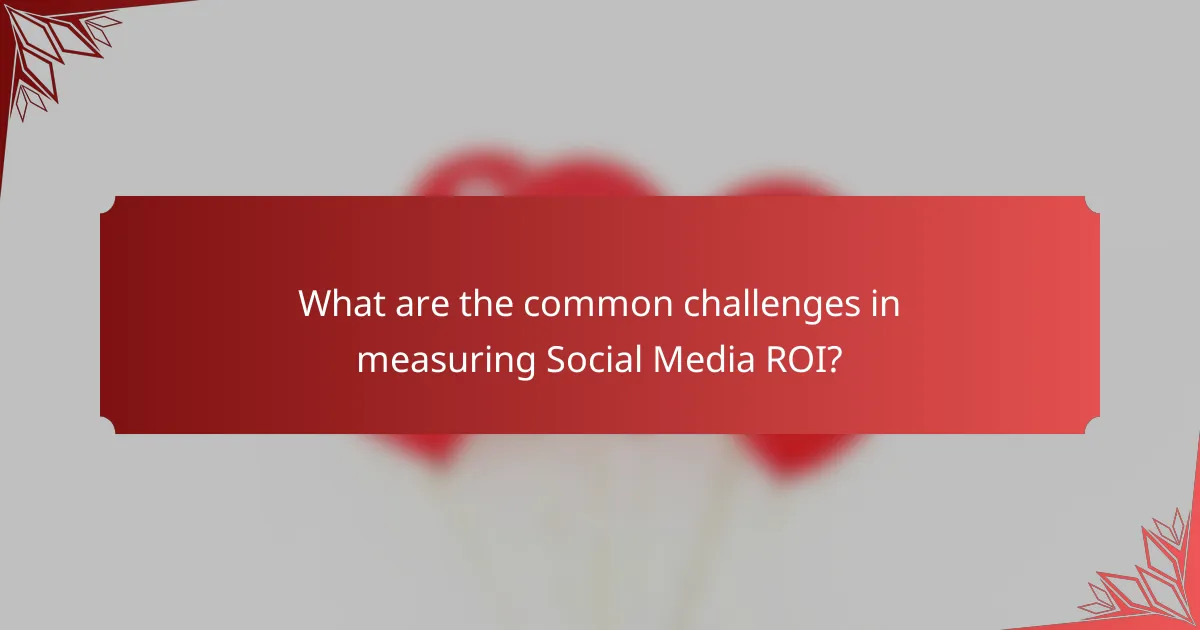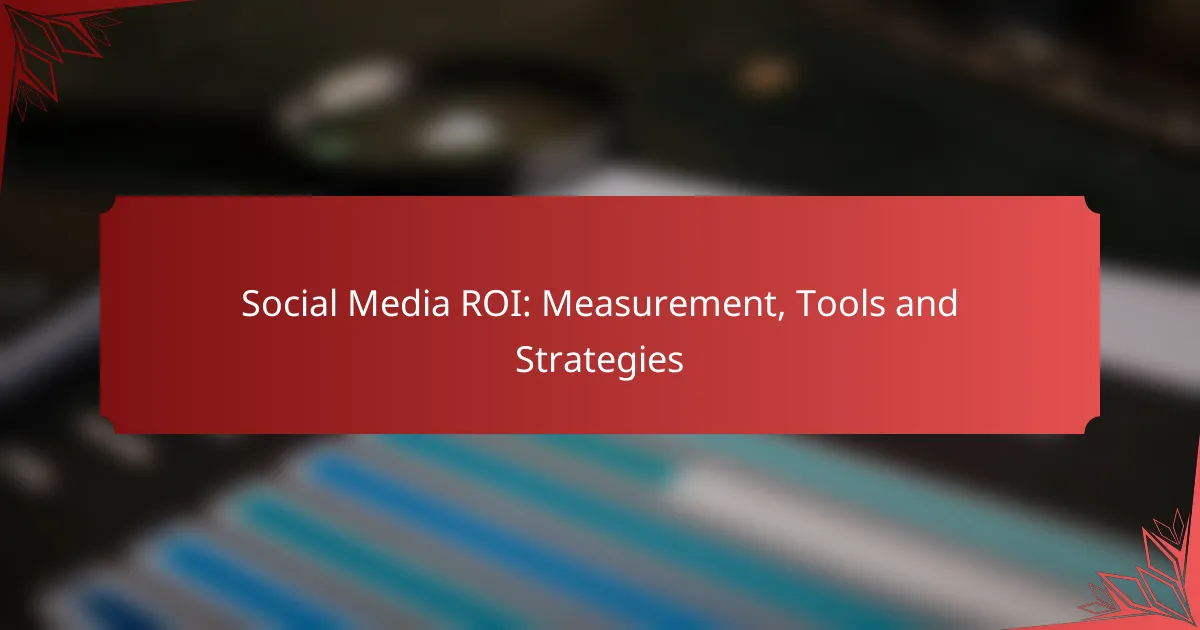Measuring social media ROI is crucial for understanding the financial returns from social media activities in relation to their costs. This process involves utilizing various metrics and tools to track engagement, conversions, and overall performance, ensuring that businesses can optimize their strategies effectively. By focusing on targeted approaches and leveraging the right tools, companies can enhance their social media investments and drive better results.

How to measure Social Media ROI effectively?
Measuring social media ROI effectively involves evaluating the financial return generated from social media activities against the costs incurred. This requires a systematic approach using various metrics and tools to assess performance and impact.
Use key performance indicators (KPIs)
Key performance indicators (KPIs) are essential for measuring social media ROI as they provide quantifiable metrics to evaluate success. Common KPIs include reach, impressions, engagement rates, and conversion rates. By setting specific, measurable goals for these indicators, you can track progress and make informed adjustments.
For instance, if your goal is to increase brand awareness, focus on metrics like reach and impressions. Conversely, for sales-driven campaigns, prioritize conversion rates and customer engagement metrics.
Calculate customer acquisition cost (CAC)
Customer acquisition cost (CAC) is the total cost of acquiring a new customer through social media efforts. To calculate CAC, divide the total marketing expenses by the number of new customers gained during a specific period. This metric helps determine the effectiveness of your social media campaigns in generating new business.
For example, if you spent $1,000 on social media ads and gained 50 new customers, your CAC would be $20. Keeping CAC low while maximizing customer lifetime value is crucial for a positive ROI.
Analyze engagement metrics
Engagement metrics, such as likes, shares, comments, and click-through rates, are vital for understanding how your audience interacts with your content. High engagement often correlates with increased brand loyalty and can lead to higher conversion rates. Regularly analyzing these metrics helps identify which content resonates most with your audience.
For effective analysis, consider using tools like Google Analytics or social media analytics platforms to track these metrics over time. Look for trends and patterns that indicate what types of posts drive the most engagement.
Implement conversion tracking
Conversion tracking allows you to measure specific actions taken by users after interacting with your social media content, such as completing a purchase or signing up for a newsletter. Setting up conversion tracking involves adding tracking codes to your website or using built-in tools from social media platforms.
For example, Facebook Ads Manager provides options to track conversions directly from your ads. This data is crucial for understanding the effectiveness of your campaigns and optimizing future strategies.
Utilize attribution models
Attribution models help assign credit to different marketing channels based on their contribution to conversions. Understanding which channels drive the most value can refine your social media strategy. Common models include first-click, last-click, and multi-touch attribution.
For instance, if a user interacts with your brand on social media before making a purchase through your website, a multi-touch attribution model would credit both channels for the conversion. This insight allows for better budget allocation and campaign optimization across platforms.

What tools are best for Social Media ROI measurement?
Effective measurement of Social Media ROI requires the right tools that can track engagement, conversions, and overall performance. The best tools not only provide analytics but also integrate with other platforms to streamline reporting and insights.
Google Analytics for tracking
Google Analytics is a powerful tool for tracking social media performance by monitoring traffic sources, user behavior, and conversion rates. By setting up UTM parameters, you can specifically track how social media campaigns contribute to website goals.
To get started, link your social media accounts to Google Analytics and create custom dashboards that highlight key metrics such as sessions, bounce rates, and goal completions. This will help you understand which platforms drive the most valuable traffic.
Hootsuite for analytics
Hootsuite offers comprehensive analytics features that allow users to measure engagement across multiple social media platforms. Its dashboard provides insights into post performance, audience growth, and engagement rates, making it easier to assess the effectiveness of your social media strategy.
Utilize Hootsuite’s reporting tools to generate visual reports that can be shared with stakeholders. This can help in identifying trends and adjusting your content strategy based on what resonates with your audience.
Sprout Social for reporting
Sprout Social specializes in social media reporting, providing detailed insights into audience demographics, engagement metrics, and content performance. Its reporting features allow you to create customized reports that align with your business objectives.
Consider using Sprout Social’s benchmarking tools to compare your performance against industry standards. This can help you identify areas for improvement and set realistic goals for your social media ROI.
HubSpot for integration
HubSpot is an all-in-one marketing platform that integrates social media management with other marketing tools, making it easier to track ROI. It allows you to connect social media efforts with email marketing, content management, and CRM systems.
By using HubSpot, you can automate reporting and gain insights into how social media interactions influence customer journeys. This holistic view can enhance your understanding of ROI across different marketing channels.

What strategies improve Social Media ROI in the UK?
Improving Social Media ROI in the UK involves targeted strategies that enhance engagement, optimize content, and leverage advertising effectively. By focusing on audience segmentation, content quality, and strategic partnerships, businesses can maximize their returns on social media investments.
Target audience segmentation
Target audience segmentation is essential for improving Social Media ROI. By dividing your audience into specific groups based on demographics, interests, and behaviors, you can tailor your messaging and campaigns to resonate more effectively with each segment.
Consider using tools like Facebook Insights or Google Analytics to analyze your audience data. This allows you to create targeted content that speaks directly to the needs and preferences of each group, ultimately increasing engagement and conversion rates.
Content optimization for engagement
Content optimization is crucial for driving engagement on social media platforms. High-quality, relevant content that aligns with your audience’s interests will encourage shares, likes, and comments, enhancing your overall ROI.
Utilize visuals, such as images and videos, as they tend to perform better than text-only posts. Aim for a mix of educational, entertaining, and promotional content, and monitor which types generate the most interaction to refine your strategy over time.
Paid advertising campaigns
Paid advertising campaigns can significantly boost your Social Media ROI by increasing visibility and reach. Platforms like Facebook and Instagram offer targeted advertising options that allow you to reach specific demographics and interests.
Set clear objectives for your campaigns, whether it’s brand awareness, lead generation, or sales. Regularly analyze the performance of your ads, adjusting your budget and targeting based on what yields the best results. A/B testing different ad formats can also help identify the most effective strategies.
Influencer partnerships
Influencer partnerships can enhance your Social Media ROI by leveraging the trust and reach of established figures in your industry. Collaborating with influencers can help you tap into their audience, increasing brand awareness and credibility.
When selecting influencers, consider their relevance to your brand and the engagement rates of their followers. Establish clear goals for the partnership, whether it’s to drive traffic, increase sales, or enhance brand perception, and track the results to measure the effectiveness of the collaboration.

What are the common challenges in measuring Social Media ROI?
Measuring Social Media ROI presents several challenges that can complicate the evaluation of effectiveness. Key issues include data integration, attribution complexity, and the need for clearly defined objectives.
Data integration issues
Data integration issues arise when combining metrics from various social media platforms and analytics tools. Different platforms may track different metrics, making it difficult to create a unified view of performance. For instance, Facebook may focus on engagement rates while Twitter emphasizes retweets and mentions.
To address these challenges, consider using comprehensive analytics tools that aggregate data across platforms. This can help streamline reporting and provide a clearer picture of overall social media performance.
Attribution complexity
Attribution complexity refers to the difficulty in determining which social media efforts contribute to conversions or sales. With multiple touchpoints in a customer journey, it can be hard to pinpoint the exact influence of each platform. For example, a user may engage with a brand on Instagram, then visit the website via a Google search before making a purchase.
To simplify attribution, utilize multi-touch attribution models that assign value to each interaction along the customer journey. This approach can provide a more accurate representation of social media’s impact on ROI.
Defining clear objectives
Defining clear objectives is crucial for measuring Social Media ROI effectively. Without specific goals, it becomes challenging to assess performance and make informed decisions. Objectives should be measurable, such as increasing brand awareness by a certain percentage or boosting engagement rates within a defined timeframe.
Establishing SMART goals (Specific, Measurable, Achievable, Relevant, Time-bound) can help clarify expectations and guide social media strategies. Regularly review these objectives to ensure they remain aligned with overall business goals and adapt as necessary.
